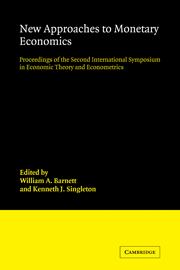 New Approaches to Monetary Economics
New Approaches to Monetary Economics Published online by Cambridge University Press: 04 August 2010
Abstract: Knowledge of the extent to which monies of different countries can substitute for each other is important for the design and implementation of monetary policy. However, existing empirical analyses of money demand in open economies rest on official estimates of money holdings that imply an infinite elasticity of substitution among different monetary assets. Existing analyses of Divisia monetary aggregates do not impose such an assumption, but do not allow foreign exchange considerations. This paper combines both approaches into a unified explanation of domestic money holdings. The empirical analysis suggests that U.S. Divisia money holdings are influenced by foreign exchange considerations. Foreign monetary policies, through their effects on both foreign interest and exchange rates, might influence domestic monetary policy directly via currency substitution.
Introduction
The purpose of this paper is to determine whether domestic money holdings are influenced by foreign exchange considerations, an influence generally known as currency substitution. Intuitively, one would expect such considerations to influence holdings of domestic money, given the increased integration of international markets and the interdependency of asset holdings. As a result, changes in either foreign interest rates or exchange rates should induce changes in the optimal portfolio mix with a corresponding impact on domestic money holdings.
Knowledge of whether currency substitution exists is important for the design and implementation of monetary policy for several reasons. First, the intended effect of an open-market operation will not materialize if offsetting portfolio changes take place through currency substitution.
To save this book to your Kindle, first ensure no-reply@cambridge.org is added to your Approved Personal Document E-mail List under your Personal Document Settings on the Manage Your Content and Devices page of your Amazon account. Then enter the ‘name’ part of your Kindle email address below. Find out more about saving to your Kindle.
Note you can select to save to either the @free.kindle.com or @kindle.com variations. ‘@free.kindle.com’ emails are free but can only be saved to your device when it is connected to wi-fi. ‘@kindle.com’ emails can be delivered even when you are not connected to wi-fi, but note that service fees apply.
Find out more about the Kindle Personal Document Service.
To save content items to your account, please confirm that you agree to abide by our usage policies. If this is the first time you use this feature, you will be asked to authorise Cambridge Core to connect with your account. Find out more about saving content to Dropbox.
To save content items to your account, please confirm that you agree to abide by our usage policies. If this is the first time you use this feature, you will be asked to authorise Cambridge Core to connect with your account. Find out more about saving content to Google Drive.